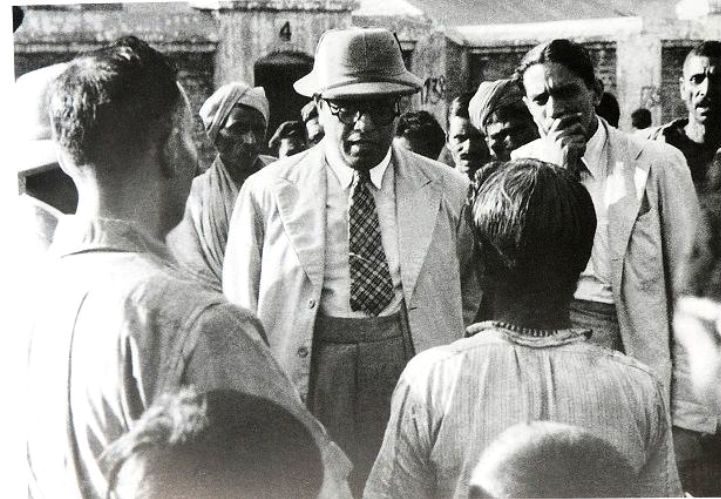Birendra Nag
 I could remember the early days of my engagement with Ambedkarite activism; I used to hear this quotation “Educate, Agitate and Organize” on Bhim Jayanti that my community in the Balangir district of the Odisha state used to celebrate every year on 14th April. At that time, I didn’t even know the source of this quotation: who might have said this, what it means so on and so forth. Further, when I ventured into different spaces of Ambedkarite engagement, both within the state and outside, most notably in Maharashtra, I came to understand different intricacies of the movement, people, and its deployment of language in understanding and fighting caste. One of the many intricacies was the concept of Educate, Agitate and Organize.
I could remember the early days of my engagement with Ambedkarite activism; I used to hear this quotation “Educate, Agitate and Organize” on Bhim Jayanti that my community in the Balangir district of the Odisha state used to celebrate every year on 14th April. At that time, I didn’t even know the source of this quotation: who might have said this, what it means so on and so forth. Further, when I ventured into different spaces of Ambedkarite engagement, both within the state and outside, most notably in Maharashtra, I came to understand different intricacies of the movement, people, and its deployment of language in understanding and fighting caste. One of the many intricacies was the concept of Educate, Agitate and Organize.
This famous quote of Dr. Babasaheb Ambedkar has been considered as one of the strongest and well-popularized messages in the Ambedkarite Movement. Moreover, it has been a matter of a hard debate specifically in the context of the Ambedkarite movement in the higher education institutions: whether the message is sequential or something else.
The Contemporary Debate
There are two prominent interpretations of this debate, existing both in the movement on the street as well as in academia. Both produce very serious knowledgeable inputs toward emancipating Dalits, as well as society in general.
The first interpretation says that the authentic sequence of Babasaheb’s quote is “educate, agitate, organize”. First educate yourself, then agitate and then organize. This interpretation has been criticized that this is an excuse to participate in the movement and engage only in gaining education. Since it does not move students towards participating in student politics in higher education institutions. While the second argument is slightly different, it says the quotation as “Educate, Organise, Agitate”. This sequence stresses that ‘organize’ is important as well. That’s how people can learn to challenge the system while educating themselves and education should not be a process in isolation. Similarly, this sequence is also criticized for its manipulation of the original one. Some say that it is communist propaganda which justifies how the working class is supposed to organize themselves before they agitate.
The Source of the Quotation
The quotation can be traced to two accounts in literature (or more than that). The first account refers to the Dr. Babasaheb Ambedkar Writing and Speeches Volume 1, in the speech called “Communal Deadlock and A Way to Solve It”. In this speech, Dr. Babasaheb Ambedkar was addressing people who gathered for a meeting organised by the Scheduled Castes Federation (SCF). Babasaheb used these words while appreciating the activists of the party who, though they do not have a press of their own, funds to educate, agitate, organise, but are still working to ensure the expansion of SCF:
“There is a lamentable lack of resources at our command. We have no money. We have no press. The cruelest of tyrannies and oppression, to which our people are subjected, day in and day out all over India, are never reported by the Press. Even our views on social and political questions are systematically suppressed by an organized conspiracy on the part of the Press. We have no funds to maintain a machinery, to render help to our people and to educate, agitate and organize them.” DBAWS, 1979, PP. 357
The second account is from a secondary source i.e. the biography of Dr. Babasaheb Ambedkar written by Dhananjay Keer. In this, the author refers to a speech by Babasaheb organised at the All India Conference of the Depressed Classes (AIDCC) at Nagpur:
“My Final Words”, he concluded “of advice to you is to educate, agitate and organise, Have faith in yourself. With Justice on our side, I do not see how we can lose our battle.” (KEER, PP 351, 1954)
Looking at the sources, the sequence that is given in the references of DBAWS and the biography of Babasaheb seems authentic, but there are a few questions that still need to be addressed. These are as follows: How to interpret the words with the location of students in higher education institutions? What are the meanings of these terms? Do they float separately or they are normatively overlapping with each other? Whether the discussion should only be about what is/should be the sequence, or it should be beyond that point too? In the conclusion, the point we come to is: why can’t all of these three terms go parallelly rather than in a sequence?
Locating Babasaheb’s Life with Educate, Agitate, Organise
The quotation can also be elucidated with looking at the life experiences of Babasaheb by unravelling how he educated, agitated and organised in his own life. Holistically, his education journey was in the following manner. He studied in the primary school of Dapoli and then his family moved to Bombay where he did his higher schooling and graduation. Afterwards, he got a scholarship from the Maharaja of Baroda for his postgraduate and doctoral studies in Colombia. Later, he travelled to London and joined MSc, DSc and Bar at Law, but meanwhile, in 1917, his scholarship got over, and he was asked by the Maharaja to return. Until these events in the life of Babasabeb, one can say that he focused only on his education. There are two reasons for making this argument. One is that he was pursuing education with a scholarship ofrom the Maharaja for a limited duration. Secondly, the contemporary socio-political movements were not focusing on the issues of the untouchables.
Moreover, he faced direct discrimination even in Baroda, which used to be called the land of progressive leaders. He resigned from his post because of the misbehaviour of his subordinates and the Maharaja’s inability to arrange a house for him in Baroda. He joined the professorship in Sydenham College, Bombay. It is very important to note that he started as an advocate with the Government during the course of which, in 1919, he gave evidence before the Southborough Committee which was dealing with the franchise in the light of the Montagu-Chelmsford Reforms. He founded a paper named “Mook Nayak” (The leader of the voiceless). These events and actions of Babasaheb can be together seen as “organise and agitate” interventions. What it implies is that Babasaheb had got clarity over the negligence of the contemporary movements on the issue of untouchability. He criticised the Indian National Congress, Muslim League, Indian National Social Conferences etc. as well as the British Government which were not taking the problems of untouchability into their agendas and policies, and were ignorant about it.
He again went back for his studies in London, as he got scholarship grants from the Maharaja of Kolhapur, Chhatrapati Shahu. He finished all his pending degrees and doctoral researches. Now, the important point of narrating these events is that at this time he continued writing for “Mook Nayak “and criticizing mainstream movements i. e. agitatiing during his studies. The very idea of continually publish newspapers was to awaken the people in a constant process of educating people and to keep up the intellectual battle.
When he returned to Bombay in 1923, he started practicing as a barrister. Along with writing for Bahishkrit Bharat, Babasaheb founded a socio-political organization called “Bahishkrit Hitakarini Sabha”. At this stage, he was practicing a barrister, i.e. “educating” himself, writing his critiques through Bahishkrit Bharat, i.e. “agitating” with and against the contemporary movements and British government and mobilizing, i.e. “organizing” the untouchable families and communities through Bahishkrit Hitkarini Sabha. Likewise, all events of Babasaheb’s socio-political movements had included education–researching for his writings–agitation and organization together. It resembles a process more than a sequence.
The terms educate, organize and agitate are not quantitative/statistical terms where one ends, and another begins. All of them are highly normative from their very principles. Even If we consider the first sequence one as the right one which is “educate, agitate, organize”, the question that came here is how are we going to put a benchmark to the first term ‘educate’ and then after reaching that benchmark point we will start to agitate and then will organize.
It is hard to conceptualize that education has to do with only completing degrees. Likewise, ‘agitate’ is participating in a public gathering or a morcha; and ‘organize’ is participating in any socio-political group/party. Though these interpretations are really important, there still exist misrepresentations of substantial synthesis with empirical insights. To get that we need to raise more questions to decode the existing arguments.
- What if a person has not got any formal education, but she/he understands the ontological reality of society better than a person who has theoretical command on the issue and also asserts her/his rights at her/his own location?
- Most of the Dalit and Adivasi children, when they enter into schools and other public spaces, face a lot of challenges. Still, they keep going to school. Isn’t that part of ‘agitate’? Even going through humiliation to access education and believing something would change–isn’t it ‘agitating’?
- Isn’t it hard to imagine a space where every term exists in isolation? Only after completion of the studies and formation of the group can one start agitating.
From the Navayana Perspective
The Navayana perspective that was given by Babasaheb in his book “Buddha and His Dhamma” states three key words i. e. “Budhha, Dhamma, Sangha” as the methodological approach to understanding the truth. One could see the direct correlation between this approach and the quotation, i.e. “Educate, Agitate, Organize”. Buddha becomes the sign of knowledge in which a person, the knowledge seeker strives to educate him/herself. It prepares the background to create epistemological methods to see the truth. Educating oneself means the same. It has to create an environment for striving for knowledge. Dhamma stands as an epistemology to gain the truth, i.e. the ways, methods through which one could meet the truth. Agitation is none other than this. The movement agitates to get its rights, dignity and entitlements. ‘Sangha’ is the community, a sense of belongingness, a feeling of a commune. The organization is also the same as the philosophy and objectives of the Sangha. And the Navayana way of thinking recognizes the parallel processual aspect of these three terms. And the whole idea of enlightenment is constituted of these elements functioning together, where agitation with mind and with the outside world become a parallel process with constantly engaging with the knowledge building process to educate oneself and others.
It is essential to understand at the micro-level that these terms overlap each other and sometimes evolve together, which can be called a meta-process of localization. As a person is born, these concepts are incorporated into his existence. By working in the fields, forming friends’ circles, the child floats into educating, agitating and organizing herself/himself with family, friends, the community around and builds her/his consciousness even before going to the school. As the consciousness develops through socialization, he starts forming an ambiguous utopia to believe in emancipation from oppression, discrimination to reform an egalitarian society. This process should be realized and practised.
~~~
Birendra Nag is currently pursuing his Masters degree at TISS, Mumbai. His area of interest is Ambedkarite Buddhist philosophy.










